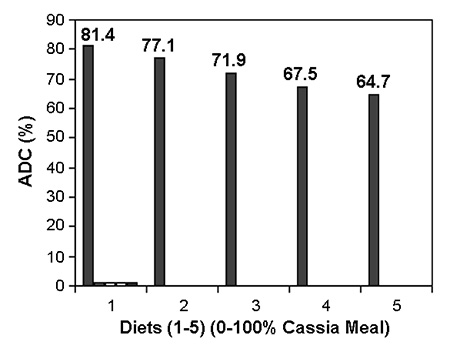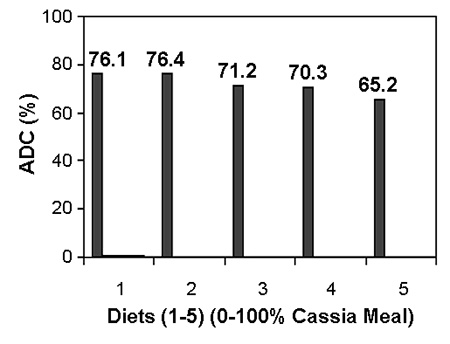Seedmeal can serve as a good source of minerals in fish diets

Conventional plant protein ingredients used in fish nutrition – such as soybean meal and groundnut cake – can be scarce and expensive due to competition for their use in both human and livestock feeds. In 2002, the first author reported that some underexploited forest seeds with high protein levels and suitable amino acid profiles could be used as replacements for expensive plant protein feedstuffs in practical diets for fish.
Study setup
A study by the authors evaluated the nutritive value of cassia (Cassia fistula), an underutilized forest seed, and its digestibility in nile tilapia (Oreochromis niloticus), a prominent freshwater aquaculture species.
Cassia seed bunches were harvested from the campus of the Federal University of Technology in Akure, Nigeria. The seeds were removed and roasted in a frying pan at 70 to 90 degrees-C for 15 to 20 minutes to reduce the moisture content and substantially reduce the anti-nutrients in cassia seeds. The seeds were cleaned and milled into fine powder to form a meal that was analyzed for proximate and mineral compositions according to standard methods.

In digestibility trials, the cassia seed meal replaced soybean meal at 0, 25, 50, 75 and 100 percent in 35 percent-crude protein diets. The diets were fed to triplicate groups of 10-g tilapia in glass tanks at 5 percent body weight per day for 14 days. Fecal samples were collected eight hours after each feeding, pooled and analyzed for proximate composition. Digestibility was calculated using the acid in-soluble ash methods.
Results
Table 1 presents the proximate composition of the Cassia fistula meal. Its protein content was high (26 percent), with low ash and fat contents, indicating that meal from cassia seeds could be used in fish nutrition. This protein level was similar to the respective values of 24.5 percent and 25.2 percent obtained by Garg et al (2002) for moong and cowpea seeds used as ingredients in tilapia diets.
The mineral composition of the cassia seed meal (Table 2) showed high values close to those in warmwater fish, indicating the meal can serve as a good source of minerals in fish diets. This composition compared well with the mineral contents of Cassia laevigata reported by Siddhuraju et al (1995).
Fish fed a control diet without cassia meal had the highest apparent protein digestibility (ADC protein), which was similar to the ADC protein of the fish fed diets with 25 percent cassia meal (Fig. 1). However, these ADC values were significantly higher than those for the fish fed diets with 50 percent, 75 percent, and 100 percent cassia meal. Also, the ADC values decreased continually as the level of cassia meal in the diets increased. The ADC energy (Fig. 2) of the fish fed diets of 0 percent, 25 percent, 50 percent, and 75 percent of cassia meal were similar, but differed significantly from the value for fish fed 100v cassia meal.
Nwanna, Proximate composition of Cassia fistula flour, Table 1
| Nutrient | Percentage |
|---|---|
| Crude protein | 26.0 |
| Crude fat | 3.14 |
| Crude fiber | 8.05 |
| Ash | 2.49 |
| Moisture | 9.82 |
| Nitrogen free extract | 50.5 |
Nwanna, Mineral composition of Cassia fistula flour, Table 2
| Mineral | b/kg |
|---|---|
| Phosphorous | 11.2 |
| Potassium | 3.7 |
| Magnesium | 2.0 |
| Calcium | 1.6 |
| Sodium | 1.2 |
| Iron | 0.3 |
| Zinc | 0.13 |
Based on these results, soybean meal could be replaced by cassia meal at a 25 percent inclusion level in O. niloticus diets for fish in the tester size range.
Note: Cited references are available from the first author.
(Editor’s Note: This article was originally published in the August 2003 print edition of the Global Aquaculture Advocate.)
Now that you've finished reading the article ...
… we hope you’ll consider supporting our mission to document the evolution of the global aquaculture industry and share our vast network of contributors’ expansive knowledge every week.
By becoming a Global Seafood Alliance member, you’re ensuring that all of the pre-competitive work we do through member benefits, resources and events can continue. Individual membership costs just $50 a year. GSA individual and corporate members receive complimentary access to a series of GOAL virtual events beginning in April. Join now.
Not a GSA member? Join us.
Authors
-
L.C. Nwanna
Department of Fisheries and Wildlife
Federal University of Technology
PMB 704 Akure, Nigeria[109,111,99,46,111,111,104,97,121,64,49,48,48,50,117,108,114,100]
-
O.A. Fagbenro
Department of Fisheries and Wildlife
Federal University of Technology
PMB 704 Akure, Nigeria -
T. Jegede
Department of Fisheries and Wildlife
Federal University of Technology
PMB 704 Akure, Nigeria
Tagged With
Related Posts

Aquafeeds
A push for rapeseed as a viable aquafeed ingredient
One Germany-based company says rapeseed protein concentrate, or RPC, can help aquafeed manufacturers meet growing demand.

Health & Welfare
‘Super male’ Nile tilapia outperform hormone-reversed fish in Nicaragua
A recent study compared the growth and survival at different salinity levels of “super male” (YY) tilapia with normal sex O. niloticus reversed to 100 percent phenotypic males.

Intelligence
Analysis of global diets highlights persistent undernutrition
Climate change, shifting incomes and evolving diets complicate the search for solutions to obesity and undernutrition in vulnerable populations.

Aquafeeds
Aquaculture Exchange: Lukas Manomaitis, USSEC
The U.S. Soybean Export Council is a huge supporter of aquaculture growth globally, as so many aquafeed formulators rely on U.S. soy to create nutritious diets. The Southeast Asia senior technical advisor for USSEC’s aquaculture program talks about this symbiotic partnership.


